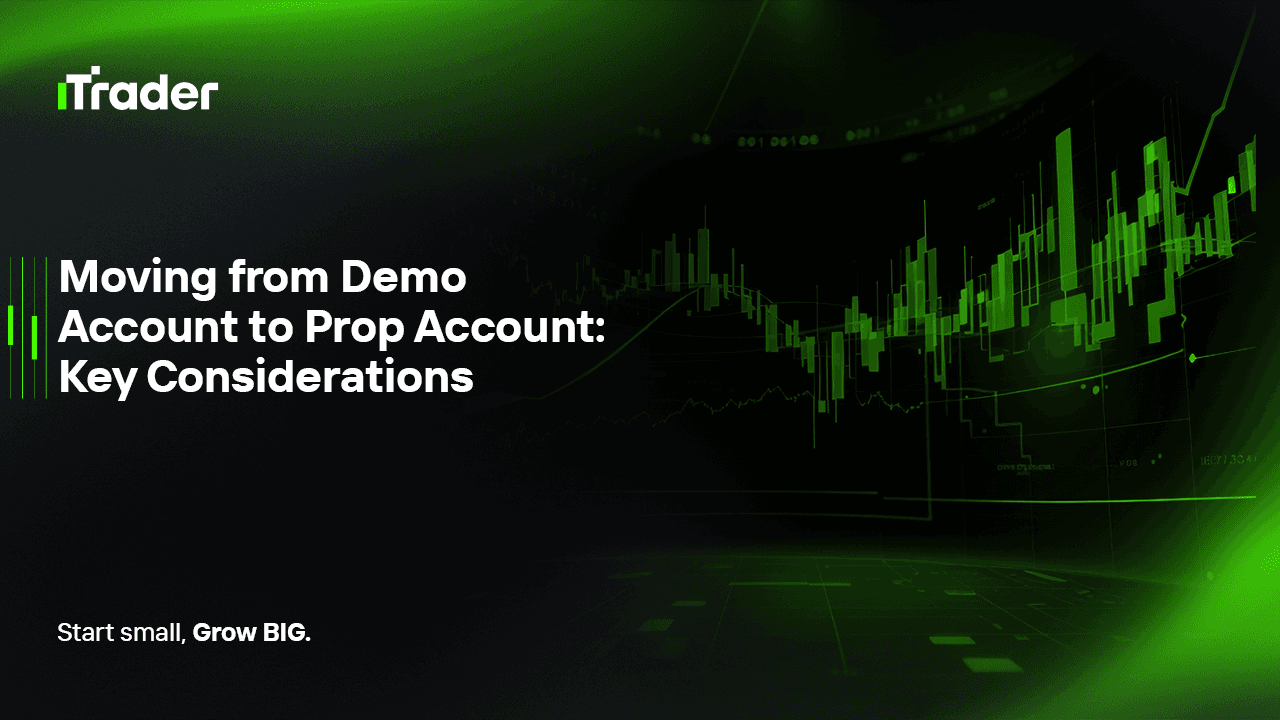2025-09-16
For most aspiring forex traders, the journey begins on a demo account. It’s a safe environment where mistakes cost nothing, strategies can be tested freely, and confidence can be built without the pressure of real money. But at some point, every trader faces the big leap — moving from demo to a prop account, where real capital is on the line and strict rules apply.

This transition isn’t just about proving your technical skills. Prop firms evaluate traders on much deeper levels: risk management, discipline, psychological resilience, and consistency. Passing this phase means showing that you can handle not only the charts but also the emotions, rules, and capital entrusted to you.
In this blog, we’ll break down what you should pay close attention to when making this critical shift, and how to prepare for success in a prop firm environment.
On the surface, demo and prop accounts look similar — you open trades, watch price movements, and manage positions. But the dynamics are very different:
Understanding these differences upfront is essential because many traders stumble not due to lack of skill but due to underestimating the psychological and structural changes.
A demo account is not just for testing whether a strategy “works.” It’s where you build the habits that will carry you through prop challenges. Before attempting a prop account, ensure you’ve:
Think of demo as your rehearsal stage. You don’t pass to the main show (prop account) until you can consistently perform on this smaller stage.
The biggest hurdle in moving from demo to prop is not technical but psychological. When money is real (even if it’s the firm’s), your brain reacts differently:
To manage this shift, you must prepare mentally as much as you prepare technically.
Prop firms don’t care if you make 20% profit in a week. They care if you can protect capital while generating returns. That’s why risk management takes center stage:
In fact, most prop firms would rather see a trader earn 5% with tight drawdowns than 15% with reckless exposure.
The goal in a prop challenge is not to prove you’re a genius trader — it’s to demonstrate you’re a reliable, consistent risk manager. Here’s how to approach it:
Remember: Prop firms are evaluating how you’d handle their money long-term, not just whether you can hit a short-term profit goal.
Moving from demo to prop should not be impulsive. A structured transition plan increases your odds of success:
This staged approach prevents emotional burnout and builds confidence step by step.
Many traders fail prop challenges not because they lack skill, but because they repeat avoidable mistakes:
Awareness of these pitfalls can help you sidestep them.
The demo account is your training ground. The prop account is your audition. Passing it successfully is not the end goal — it’s the beginning of your professional career.
Think of it as stages:
Each stage builds on the previous one. Skipping steps or rushing leads to failure, while gradual mastery leads to long-term success.
Transitioning from demo to prop is one of the most challenging and important steps in a trader’s journey. The skills that served you well on demo — strategy testing, execution practice, risk calculation — now must be reinforced with discipline, emotional control, and strict adherence to rules.
To succeed, remember:
If you respect the process, master your emotions, and trade with consistency, you’ll not only pass prop challenges but also position yourself as a trader capable of long-term growth and professional success.
© 2025 iTrader Global Limited | 회사 등록번호: 15962
iTrader Global Limited는 코모로 연방 앙주앙 자치섬의 무잠두(Hamchako, Mutsamudu)에 위치하고 있으며, 코모로 증권위원회(Securities Commission of the Comoros)의 인가 및 규제를 받고 있습니다. 당사의 라이선스 번호는 L15962/ITGL입니다.
iTrader Global Limited는 “iTrader”라는 상호로 운영되며, 외환 거래 활동에 대한 인가를 받았습니다. 회사의 로고, 상표 및 웹사이트는 iTrader Global Limited의 독점 재산입니다.
iTrader Global Limited의 다른 자회사로는 iTrader Global Pty Ltd가 있으며, 이 회사는 호주 회사 등록번호(ACN): 686 857 198을 보유하고 있습니다. 해당 회사는 Opheleo Holdings Pty Ltd의 공식 대리인(AFS 대표 번호: 001315037)이며, Opheleo Holdings Pty Ltd는 호주 금융서비스 라이선스(AFSL 번호: 000224485)를 보유하고 있습니다. 등록 주소는 Level 1, 256 Rundle St, Adelaide, SA 5000입니다.
면책 조항: 이 회사는 본 웹사이트에서 거래되는 금융 상품의 발행인이 아니며 이에 대해 책임을 지지 않습니다.
위험 고지: 차액결제거래(CFD)는 레버리지로 인해 자본 손실이 빠르게 발생할 수 있는 높은 위험을 수반하며, 모든 사용자에게 적합하지 않을 수 있습니다.
펀드, CFD 및 기타 고레버리지 상품의 거래에는 전문적인 지식이 요구됩니다.
연구 결과에 따르면 레버리지 거래자의 84.01%가 손실을 경험하고 있습니다. 거래에 참여하기 전에 관련 위험을 충분히 이해하고 전체 자본을 잃을 준비가 되어 있는지 확인하십시오.
iTrader는 레버리지 거래로 인해 발생하는 손실, 위험 또는 기타 피해에 대해 개인 또는 법인에게 전적인 책임을 지지 않음을 명시합니다.
이용 제한: iTrader는 해당 활동이 법률, 규제 또는 정책에 따라 금지된 국가의 거주자를 대상으로 본 웹사이트나 서비스를 제공하지 않습니다.